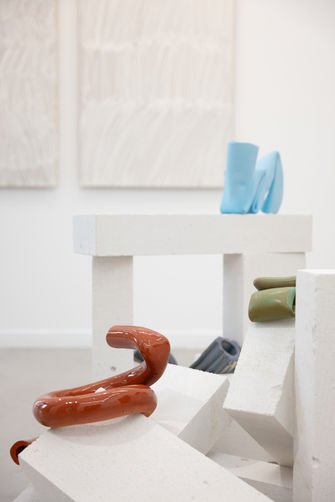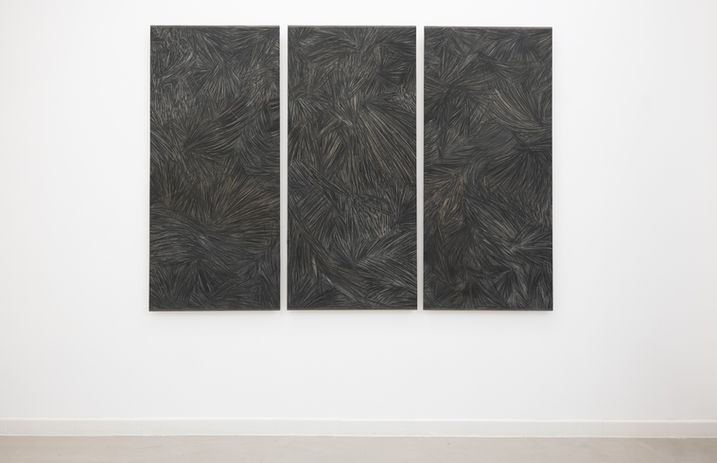BOUNDLESS BOUNDARIES
Alexandre Clanis & Anni Mertens
From 29 June until 09 September 2023
Boundless boundaries presents the work of Alexandre Clanis (1988, FR) and Anni Mertens (1995, LU) — an interplay between painting and sculpture.
Anni Mertens works with ceramics, steel, found objects and a healthy dose of humour. Anni playfully bends, coats and twists materials in such a way that it is hard to distinguish what’s solid and what’s soft, what’s delicate and what’s not. Anni’s sculptures situate themselves somewhere between extensions and analogies of the body.
Alexandre Clanis’ practice evolves around imprints and the experience of space. The imprint reveals the action of the body in its most primitive form — By repeating a gesture, the body emancipates itself from all intention. Always working on the ground, the act of painting becomes an experience.
Alexandre Clanis
Born 1990 in Bordeaux France.
Lives and works in Bordeaux, France.
Alexandre Clanis studied architecture at La Cambre in Brussels, and in Bordeaux. Between 2017 and today he has been part of several exhibitions in Belgium, France, Portugal, Germany, The Netherlands and Australia.
Alexandre Clanis uses painting as a means of questioning the eye and preparing it to confront the unexpected. His paintings capture and entangle the viewer. They create a confrontation between fragmented bodies composed of traces and movements. Time unfolds on the painted surfaces. We can sense breathing: vibrations echo and rhythms accelerate. It is like a poem that fades as it is written, the painter's research suggests a reflection on the intangible, the indescribable. In the studio, Alexandre Clanis paints his works on the floor. From horizontal to vertical, his body and gaze are confronted with the canvas. Following an assumption of abandonment, he advances into forms, grids and whites. His paintings are created by subtracting matter or drawing in air, revealing an "emotional chemistry " composed of a sequence of blurs and hazes. These mists penetrate the surface and are embedded between the motifs, creating depth.
Just as one would enter a forest at nightfall, Alexandre Clanis questions the unconscious: The canvas becomes a wave, a skin vibrating with energy and memory. The artist's relationship with space and its investigation recalls his training as an architect. (Text © Elise Girardot)
Clanis’ work can be differentiated with different series of works, such as Sténopé, Avant le trait, Empreintes and Images du mouvement.
Sténopé — Pinhole camera
The aim in this series is to reveal a latent image of movement by playing on the transition from imprint to trace. This work on subtraction echoes the "pinhole" process used to obtain a negative of the photographic image. On an industrial canvas laid on the floor, the painter creates an organic movement in white paint. His fingertips trace a mesh of lines, and a flow gradually takes shape upon contact with the canvas. A dialogue develops between the pressure of the finger and the material. By settling, the paint impregnates the canvas, leaving an imprint. Then, under the effect of the vibrations generated by the painter, the paint withdraws: the imprint becomes a trace, the background appears, the canvas finds its movement. In this way, removal plays as much a part in the rhythm of the work as the line.
Empreintes — Imprint
The imprint reveals the action of the body in its most primitive form. By repeating the gesture, the body frees itself of all will. The palm of the hand, the pad of the fingers or the heel carry the intention and create a form of writing: a language of contact. The body traces its path in an archaic way. It's a trace of movement, a path transcribed by white paint without pretension or ornament. The abandonment of means participates in the abandonment of the self, the noise is reduced to let the imprint form in silence. Playing on the frontier of nothingness, the painter and his movement draw a line between what is and what is becoming. A first dialogue is established with the painting, a mutual exploration to understand and interact. On the canvas, the bare gesture is transformed into repeated impulses and spontaneous variations. The paintings respond and shift, weaving a territory. An overall rhythm supports intimate perceptions at every glance.
Avant le trait — Exhaustion of the tool
Before the line, there is the trace. When all intention is removed from the line, what remains is the trace: a mechanical act, testifying to the transit of a being or an object. The " Exhaustion of the Tool " series pushes drawing towards a form of nudity. Here, drawing is reduced to an oscillation, on the verge of absurdity. It’s about exhausting a tool (her a pencil) on a sheet of sandpaper until it disappears, covering the surface with traces. The stripping-down nature of the gesture distances it from any intention: the act is not subject to a goal or an idea of beauty. A sense of silence emerges, a space of discretion. The abrasive surface of the sandpaper consumes the material of the painting tool (charcoal, plaster or parafin), leaving a layer of particles. The surface preserves the imprint of the sanding, the memory of the movement. The drawing here takes on a performative dimension: an oscillatory phenomenon, produced in a single block of time, as a measure of time and space.
Images du mouvement
‘Images du mouvement’ is an investigation between performance and drawing. The idea is to make visible, through an image of friction, our contact with the world. Wrapping himself in a sheet of sandpaper, the artist rubs himself against the wall, pressing down various points of force on his body (his elbow, shoulder, knees…). Traces of his contact with the wall appear on the surface of the material (here in white). Taking away the material of the wall, these white zones appear as luminous breakthroughs in the black intensity of the raw material. The idea of image interests the artists, since there is a big flow
« I paint to explore silence, to question a space before language »
- Alexandre Clanis
Anni Mertens
Born 1995 in Luxembourg.
Lives and works in Rotterdam, The Netherlands.
Anni Mertens graduated with a BA in Fine Arts at HKU, Utrecht, The Netherlands and an MA in Fine Art, focused on ceramic and glass at LUCA School of Arts, Gent, Belgium. She has been part of the ‘Best of Graduates Group Show’ at the prestigious Galerie Ron Mandos, Amsterdam in 2019 and has been part of numerous exhibitions in Belgium, the Netherlands and Luxembourg ever since. She has won multiple awards, such as the Kunstliefprijs in 2020 (NL) The Biennale ViArt 2021 (LU), and the Prix Jeune Talent CAL, 2022 (LU) and has been nominated for the Prix d’Art Robert Schuman in 2023.
Anni Mertens works with ceramics, steel, found objects and a healthy dose of humour. Her sculptural work embraces both abstraction and disfiguration, the same as precision and looseness. Once her individual sculptures are grouped together on diverse structures, they form a theatre of the absurd.
Anni playfully bends, coats and twists materials in such a way that it is hard to distinguish what’s solid and what’s soft, what’s delicate and what’s not. The skeuomorphic objects that make up the installations find common ground in their relationship with the body. These objects situate themselves somewhere between extensions and analogies of the body, playing visual and spatial games as they form a trail, seeking poetic coherence between shape, colour and textures bending and flexing concrete and ceramics while exploring the limits of their material capacities. The inspiration of the play-drive or the play impulse, explains why there are always playful elements coming back in her installations. Intuition plays an important role in her process, so she follows the material and the material follows back. The assemblage of sculptures refer to our journeys which are filled with the unexpected, questioning how we grow throughout these journeys and do we ever outgrow the urge to play?





























